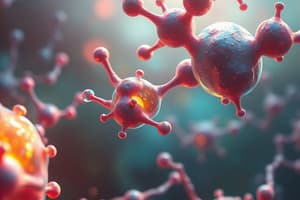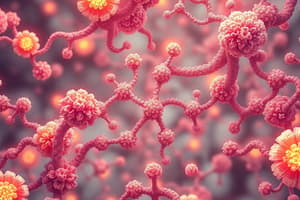Podcast
Questions and Answers
What is a key function of proteins within living organisms?
What is a key function of proteins within living organisms?
- Store genetic information
- Provide energy storage
- Regulate biochemical processes (correct)
- Facilitate cellular respiration
Which process involves the synthesis of complex molecules from simpler ones?
Which process involves the synthesis of complex molecules from simpler ones?
- Fermentation
- Anabolism (correct)
- Glycolysis
- Catabolism
What is the primary energy currency found in cells?
What is the primary energy currency found in cells?
- FADH2
- GTP
- ATP (correct)
- NADH
What role do cofactors play in enzymatic activity?
What role do cofactors play in enzymatic activity?
What is the process called by which DNA is transcribed to messenger RNA?
What is the process called by which DNA is transcribed to messenger RNA?
Which biochemical technique is specifically used for separating molecules based on their size and charge?
Which biochemical technique is specifically used for separating molecules based on their size and charge?
In cellular respiration, which stage is responsible for the conversion of glucose to pyruvate?
In cellular respiration, which stage is responsible for the conversion of glucose to pyruvate?
Which of the following statements best describes the role of nucleic acids?
Which of the following statements best describes the role of nucleic acids?
Flashcards are hidden until you start studying
Study Notes
Biochemistry Study Notes
-
Definition:
- Biochemistry is the study of chemical processes within and related to living organisms.
-
Key Concepts:
- Macromolecules: Large molecules crucial for biological function.
- Proteins: Composed of amino acids; critical for structure, function, and regulation.
- Nucleic Acids: DNA and RNA; carry genetic information and play roles in protein synthesis.
- Carbohydrates: Includes sugars and starches; provide energy and structural support.
- Lipids: Fatty acids and their derivatives; important for cell membranes and energy storage.
- Macromolecules: Large molecules crucial for biological function.
-
Metabolism:
- Catabolism: Breakdown of molecules to release energy.
- Anabolism: Synthesis of complex molecules from simpler ones, requiring energy.
-
Enzymes:
- Biological catalysts that speed up chemical reactions.
- Characteristics:
- Specificity: Enzymes are specific to substrates.
- Active Sites: Regions where substrates bind.
- Cofactors: Non-protein helper molecules needed for activity.
-
Energy Transfer:
- ATP (Adenosine Triphosphate): Primary energy currency in cells.
- Cellular Respiration: Process that converts biochemical energy from nutrients into ATP.
- Stages include Glycolysis, Krebs Cycle, and Electron Transport Chain.
-
Gene Expression:
- Process by which information from a gene is used to synthesize functional gene products (usually proteins).
- Includes transcription (DNA to mRNA) and translation (mRNA to protein).
-
Biochemical Techniques:
- Chromatography: Separation of mixtures based on component properties.
- Electrophoresis: Technique for separating molecules based on size and charge.
- Western Blotting: Method for detecting specific proteins in a sample.
-
Importance in Health:
- Biochemistry is essential for understanding metabolic disorders, genetic diseases, and drug development.
-
Applications:
- Biotechnology, pharmaceuticals, agricultural advancements.
-
Current Trends:
- Emphasis on systems biology and molecular biology techniques to understand complex interactions within biological systems.
Biochemistry
- The study of chemical processes in living organisms.
- Focuses on the structure and function of biomolecules, including proteins, nucleic acids, carbohydrates, and lipids.
- Explores the interactions and reactions between these molecules, which underpin life processes.
Macromolecules
- Large molecules essential for biological functions.
- Four main categories: proteins, nucleic acids, carbohydrates, and lipids.
Proteins
- Polymers composed of amino acid monomers.
- Perform diverse roles, including:
- Structural support (e.g., collagen)
- Catalysis (enzymes)
- Transport (e.g., hemoglobin)
- Signaling (hormones)
Nucleic Acids
- DNA (deoxyribonucleic acid) and RNA (ribonucleic acid).
- Store and transmit genetic information.
- DNA: Contains the genetic code for all organisms.
- RNA plays crucial roles in protein synthesis.
Carbohydrates
- Sugars and starches.
- Primary energy source for cells.
- Provide structural support (e.g., cellulose in plants).
- Classified by the number of sugar units:
- Monosaccharides (single unit, e.g., glucose)
- Disaccharides (two units, e.g., sucrose)
- Polysaccharides (many units, e.g., starch)
Lipids
- Fatty acids and their derivatives.
- Important for cell membranes, energy storage, and hormone production.
- Types:
- Triglycerides: Major energy storage form
- Phospholipids: Key components of cell membranes
- Steroids: Include cholesterol and hormones
Metabolism
- The sum of all chemical reactions occurring in a living organism.
- Two main types:
- Catabolism: Breakdown of complex molecules into simpler ones, releasing energy.
- Anabolism: Synthesis of complex molecules from simpler ones, requiring energy.
Enzymes
- Biological catalysts that accelerate chemical reactions without being consumed.
- Highly specific to substrates, binding at the active site.
- Many require cofactors (non-protein molecules) for activity.
Energy Transfer
- ATP (adenosine triphosphate) is the primary energy currency in cells.
- Cellular respiration converts energy from nutrients into ATP through a series of steps:
- Glycolysis (breakdown of glucose)
- Krebs Cycle (production of electron carriers)
- Electron Transport Chain (ATP generation)
Gene Expression
- The process of converting genetic information into functional gene products (usually proteins).
- Two main stages:
- Transcription: Copying genetic information from DNA into RNA.
- Translation: Decoding RNA to assemble amino acids into proteins.
Biochemical Techniques
- Used to study biomolecules and processes.
- Examples:
- Chromatography: Separates mixtures based on different properties of components.
- Electrophoresis: Separates molecules based on size and charge.
- Western Blotting: Detects specific proteins in a sample.
Importance in Health
- Underpins understanding of metabolic, genetic, and infectious diseases.
- Essential for drug development and personalized medicine.
Applications
- Biotechnology: Using organisms or their components for technological applications.
- Pharmaceuticals: Developing and manufacturing drugs.
- Agricultural advancements: Improving crop yield and disease resistance.
Current Trends
- Emphasis on systems biology: Studying complex interactions between biological components.
- Advances in molecular biology techniques for studying gene expression and protein function.
Studying That Suits You
Use AI to generate personalized quizzes and flashcards to suit your learning preferences.




